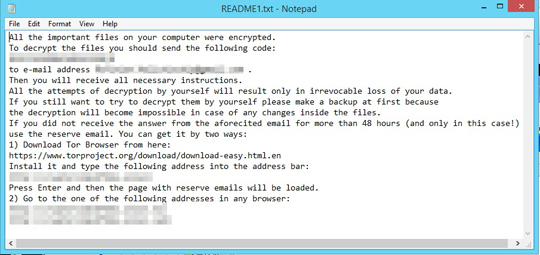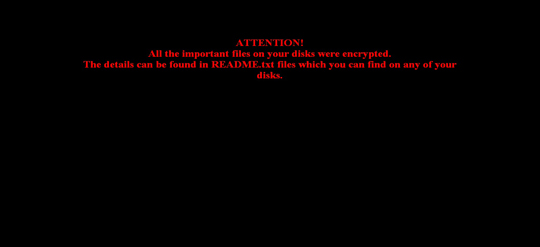RANSOM_CRYPSHED.D
Windows


Threat Type: Trojan
Destructiveness: No
Encrypted:
In the wild: Yes
OVERVIEW
This Trojan may be downloaded by other malware/grayware from remote sites.
It downloads a file from a certain URL then renames it before storing it in the affected system. It executes the downloaded files. As a result, malicious routines of the downloaded files are exhibited on the affected system.
It connects to certain websites to send and receive information.
TECHNICAL DETAILS
Arrival Details
This Trojan may be downloaded by the following malware/grayware from remote sites:
- JS_CRYPSHED.B
Installation
This Trojan drops the following copies of itself into the affected system:
- %All Users Profile%\Application Data\Windows\csrss.exe (Windows XP and below)
- %All Users Profile%\Windows\csrss.exe (Windows Vista and above)
(Note: %All Users Profile% is the All Users folder, where it usually is C:\Documents and Settings\All Users on Windows 2000, Windows Server 2003, and Windows XP (32- and 64-bit); C:\ProgramData on Windows Vista (32- and 64-bit), Windows 7 (32- and 64-bit), Windows 8 (32- and 64-bit), Windows 8.1 (32- and 64-bit), Windows Server 2008, and Windows Server 2012.)
It drops the following files:
- %Application Data%\{8 Random Alphanumeric Characters}{Same Characters as first 8}.bmp
- %User Temp%\cached-certs
- %User Temp%\cached-microdesc-consensus
- %User Temp%\cached-microdescs.new
- %User Temp%\lock
- %User Temp%\state
(Note: %Application Data% is the Application Data folder, where it usually is C:\Documents and Settings\{user name}\Application Data on Windows 2000, Windows Server 2003, and Windows XP (32- and 64-bit); C:\Users\{user name}\AppData\Roaming on Windows Vista (32- and 64-bit), Windows 7 (32- and 64-bit), Windows 8 (32- and 64-bit), Windows 8.1 (32- and 64-bit), Windows Server 2008, and Windows Server 2012.. %User Temp% is the user's temporary folder, where it usually is C:\Documents and Settings\{user name}\Local Settings\Temp on Windows 2000, Windows Server 2003, and Windows XP (32- and 64-bit); C:\Users\{user name}\AppData\Local\Temp on Windows Vista (32- and 64-bit), Windows 7 (32- and 64-bit), Windows 8 (32- and 64-bit), Windows 8.1 (32- and 64-bit), Windows Server 2008, and Windows Server 2012.)
It leaves text files that serve as ransom notes containing the following:

- {Root Drives}\README{number 1 to 10}.txt
- %System Root%\Users\Public\Public Desktop\README{number 1 to 10}.txt (Windows Vista and Above)
- %All Users Profile%\Desktop\README{number 1 to 10}.txt (For Windows XP and Below)
- %Desktop%\README{number 1 to 10).txt
Autostart Technique
This Trojan adds the following registry entries to enable its automatic execution at every system startup:
HKEY_CURRENT_USER\Software\Microsoft\
Windows\CurrentVersion\Run
Client Server Runtime Subsystem = %All Users Profile%\Application Data\Windows\csrss.exe (Windows XP and below)
HKEY_CURRENT_USER\Software\Microsoft\
Windows\CurrentVersion\Run
Client Server Runtime Subsystem = %All Users Profile%\Windows\csrss.exe (Windows Vista and above)
Other System Modifications
This Trojan adds the following registry keys:
HKEY_LOCAL_MACHINE\SOFTWARE\System32\
Configuration
HKEY_CURRENT_USER\SOFTWARE\System32\
Configuration
It adds the following registry entries:
HKEY_LOCAL_MACHINE\SOFTWARE\System32\
Configuration
pk = {PUBLIC KEY}
HKEY_LOCAL_MACHINE\SOFTWARE\System32\
Configuration
cnt = {numbers}
HKEY_LOCAL_MACHINE\SOFTWARE\System32\
Configuration
mode = 0
HKEY_LOCAL_MACHINE\SOFTWARE\System32\
Configuration
state = 5
HKEY_LOCAL_MACHINE\SOFTWARE\System32\
Configuration
i = {random characters}
HKEY_LOCAL_MACHINE\SOFTWARE\System32\
Configuration
Version = 7.2.0.3
HKEY_CURRENT_USER\SOFTWARE\System32\
Configuration
pk = {PUBLIC KEY}
HKEY_CURRENT_USER\SOFTWARE\System32\
Configuration
cnt = {numbers}
HKEY_CURRENT_USER\SOFTWARE\System32\
Configuration
mode = 0
HKEY_CURRENT_USER\SOFTWARE\System32\
Configuration
state = 3
HKEY_CURRENT_USER\SOFTWARE\System32\
Configuration
i = {random characters}
HKEY_CURRENT_USER\SOFTWARE\System32\
Configuration
Version = 7.2.0.3
HKEY_LOCAL_MACHINE\SOFTWARE\System32\
Configuration
sys = 1
HKEY_CURRENT_USER\SOFTWARE\System32\
Configuration
sys = 1
It modifies the following registry entries:
HKEY_CURRENT_USER\Control Panel\Desktop
wp = "%Application Data%\{random characters}.bmp"
(Note: The default value data of the said registry entry is "{user-defined}".)
It sets the system's desktop wallpaper to the following image:
- %Application Data%\{8 random alphanumeric characters}{Same characters as first 8}.bmp

Download Routine
This Trojan downloads files from the following URLs then renames them before storage in the affected system:
- URLs varies based from the list received from the servers
It saves the files it downloads using the following names:
- %User Temp%\{8 Random Alphanumeric Strings}.exe
(Note: %User Temp% is the user's temporary folder, where it usually is C:\Documents and Settings\{user name}\Local Settings\Temp on Windows 2000, Windows Server 2003, and Windows XP (32- and 64-bit); C:\Users\{user name}\AppData\Local\Temp on Windows Vista (32- and 64-bit), Windows 7 (32- and 64-bit), Windows 8 (32- and 64-bit), Windows 8.1 (32- and 64-bit), Windows Server 2008, and Windows Server 2012.)
It then executes the downloaded files. As a result, malicious routines of the downloaded files are exhibited on the affected system.
Information Theft
This Trojan gathers the following data:
- Computer Information
- Network Information
- IP Address
- List of Logical Drives
- User Name
- OS Version
Other Details
This Trojan connects to the following URL(s) to get the affected system's IP address:
- whatismyipaddress.com
It connects to the following website to send and receive information:
- http://{server}/{path}
where {server} can be any of the following:- {BLOCKED}.{BLOCKED}.40.189
- {BLOCKED}.{BLOCKED}.32.5
- {BLOCKED}.{BLOCKED}.0.39
- {BLOCKED}.{BLOCKED}.21.38
- {BLOCKED}.{BLOCKED}.206.212
- {BLOCKED}.{BLOCKED}.251.203
- {BLOCKED}.{BLOCKED}.17.194
- {BLOCKED}.{BLOCKED}.244.244
- {BLOCKED}.{BLOCKED}.223.34
- {BLOCKED}.{BLOCKED}.193.9
- http://{BLOCKED}h2ldj3v.onion
- reg.php
- prog.php
- err.php
- cmd.php
- sys.php
It encrypts files with the following extensions:
- edml
- raw
- jpg
- jpeg
- jpe
- bmp
- png
- tif
- tiff
- dib
- gif
- svg
- svgz
- rle
- tga
- vda
- icb
- wbm
- wbmp
- jpf
- jpx
- jp2
- j2k
- j2c
- jpc
- avi
- mkv
- mov
- mp4
- wmv
- 3gp
- mpg
- mpeg
- m4v
- divx
- mpv
- m1v
- dat
- anim
- m4a
- qt
- 3g2
- f4v
- mkidx
- mka
- avs
- vdr
- flv
- bin
- mp3
- wav
- asx
- pls
- zip
- 7z
- rar
- tar
- gz
- bz2
- wim
- xz
- c
- h
- hpp
- cpp
- php
- php3
- php4
- php5
- py
- pl
- sln
- js
- json
- inc
- sql
- java
- class
- ini
- asm
- clx
- tbb
- tbi
- tbk
- pst
- dbx
- cbf
- crypted
- tib
- eml
- fld
- vbm
- vbk
- vib
- vhd
- 1cd
- dt
- cf
- cfu
- mxl
- epf
- vrp
- grs
- geo
- elf
- lgf
- lgp
- log
- st
- pff
- mft
- efd
- md
- dmp
- fdb
- lst
- fbk
- sw
- vdw
It renames encrypted files using the following names:
- {random characters}.better_call_saul
- {Original File Name}.los_pollos - if filename encryption fails
SOLUTION
Step 1
Before doing any scans, Windows XP, Windows Vista, and Windows 7 users must disable System Restore to allow full scanning of their computers.
Step 2
Note that not all files, folders, and registry keys and entries are installed on your computer during this malware's/spyware's/grayware's execution. This may be due to incomplete installation or other operating system conditions. If you do not find the same files/folders/registry information, please proceed to the next step.
Step 3
Remove the malware/grayware file that dropped/downloaded RANSOM_CRYPSHED.D. (Note: Please skip this step if the threat(s) listed below have already been removed.)


